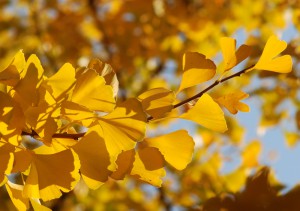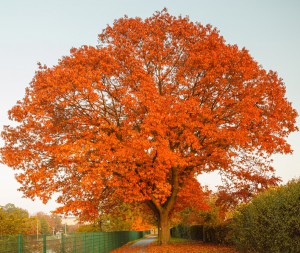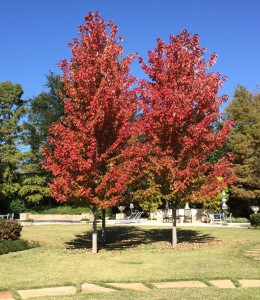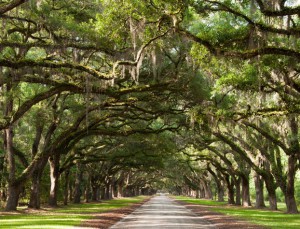
How to Add Fall Color to Your Landscape with Trees
Many homeowners think spring when they think about landscaping, but fall is actually the best time to add trees and shrubs to your yard. In Dallas, the soil stays warm enough throughout the winter (40 degrees or above) for roots to grow and gain strength. Trees planted now get a head start on establishing roots before spring when they come out of dormancy and experience a growth spurt as they develop leaves.
There are a number of considerations when choosing a tree or trees to plant, which I covered in a previous post, and planting trees should be undertaken with a thorough knowledge of what you are doing. Trees that are not planted properly (incorrect depth, burlap exposed, excessive mulch) or not watered properly may never thrive. Mistakes made during planting are next to impossible to correct later. The International Society of Arboriculture has a tip sheet that provides some good basic information on planting trees.
When fall foliage is upon us, many of our clients want to add trees to their landscape that add color. Albert Camus captured the feelings of many when he said, “Autumn is a second spring where every leaf is a flower.” Here is a rundown on several of the more popular landscaping choices for fall color:
The Chinese pistache (sometimes called Chinese pistachio) is known as the “ugly duckling” of the tree world. It starts out rather gawky and misshapen when it’s young and requires structural pruning in its early years but grows into a beautiful tree. While related to the pistachio tree, this species does not produce nuts. The Chinese pistache grows at a medium rate of 13 to 24 inches per year and the male tree grows to heights of 25 to 35 feet with a spread of 25 to 35 feet (female trees can grow taller). The Chinese pistache can live for centuries in favorable conditions. It is a hardy tree commonly used in xeriscaping because it is heat and drought-tolerant and tolerates urban conditions well. Perhaps best of all, the Chinese pistache displays spectacular color in the fall, turning luminous shades of orange and red to gold.
Gingko trees (sometimes called “maidenhair trees” because their leaves resemble those of the maidenhair fern) are known for their distinctive, fan-shaped leaves that are green throughout the year until fall when they turn a breathtaking yellow-gold. Making them even more unique is the fact that Gingkos are considered living fossils. (A “living fossil” is a non-scientific term for living species that appears to be similar to a species otherwise known only from fossils, typically with no close living relatives. Gingko tree varieties grew worldwide 200 million years ago.) Gingkos are generally slow-growing, hardy, deep-rooted trees that tolerate most well-drained soils. Popular cultivars include Fairmount, a columnar or upright tree that can reach heights of 50 feet with a spread of 15 to 18 feet and Autumn Gold, a spreading tree that can grow 25 to 50 feet with a 25 to 35 foot wide canopy. Male Gingko trees are preferred because the seeds of the female tree have a distinctive, unpleasant smell as they decay that has been likened to rancid butter.
Cedar elm trees are very popular in Texas. They are very drought tolerant and survive in difficult soil types with very little care. While most elms put out their flowers in spring, the cedar elm flowers, fruits and puts on a brilliant show of yellow gold in the fall. The tree has a medium growth rate of 13 to 24 inches a year and generally reaches heights of 50 to 70 inches and a width of 40 to 60 feet at maturity.
That said, according to the Native Plant Society of Texas, “How tall it can get depends on the soil – harsh limestone outcroppings may limit it to 20 feet tall, while the State Champion Cedar Elm grows in rich river bottom soil in Dallas, Texas and is 83 feet tall. (Note: the previous National Champion Cedar Elm was 94 feet tall near Oletha in Limestone County.)” Cedar elms are susceptible to Dutch elm disease, a fungus spread by elm bark beetles. Infection is usually first noticeable on upper branches of the tree; leaves will start to wither and yellow in summer, months before normal autumnal leaf shedding.
October Glory® maple, along with Red Sunset® are the two most popular red maples in cultivation due to their beautiful fall color and rapid growth rate. The October Glory® maple grows 40 to 50 feet high with a 25 to 35 foot spread. A beautiful shade tree addition to any yard, the tree’s dark green leaves turn brilliant red in the fall.
Red Sunset® maple, like the October Glory® maple, is a cultivar of red maple that is well-liked for its rapid growth rate and brilliant orange-red fall foliage. It thrives in both wet and dry conditions, and tolerates a wide range of soils. It grows 45 to 50 feet tall and has a 35 to 40 foot spread.
Autumn Blaze® maple is a hybrid resulting from a cross between red maple and silver maple. From the silver maple it gets its tolerance to drought and poor soil conditions and vigorous growth rate and from the red maple, it gets its strength (well-balanced branching) and fall color. Growing 50 to 60 feet tall and 30 to 40 feet wide, the Autumn Blaze® maple’s unexcelled growth rate allows it to especially thrive on high levels of nitrogen fertilizer. Under good conditions, it can grow three feet or more per year. Its foliage is green from spring until autumn when the leaves turn bright orange-red, the color of a blazing fire.
The Shumard red oak, named after a Texas state geologist and physician, Benjamin Franklin Shumard, is a moderately fast-growing tree that can grow to heights of 120 feet and widths of 50 to 60 feet or more. Leaves are a rich green that turn scarlet in the fall, making a dramatic landscaping statement. This oak grows the tallest on moist, well-drained soils but is also adapted to drier limestone soils and high pH levels.
Another red oak is the pin oak, which grows in Oklahoma, Arkansas, and parts of east Texas. It does not grow well in the Dallas area. It is important to note because oak trees cross-breed readily and pin oak crossing with Shumard and Texas red oaks is a major problem in Texas. Therefore, it is important to specify when buying a red oak tree that you want a Shumard.
All red oaks are intolerant of construction damage to their roots. If construction is taking place on the property is it imperative to minimize all compaction to the root zone by preventing traffic of any kind over the roots. Many people are unaware that 50% of a tree’s root system is in the top one foot of soil and over 90% of the root system is in the top three feet. Additionally, a tree’s root system is large and extends well beyond the tree’s dripline, often extending a distance equal to two to three times the tree’s height. Symptoms of root damage may be apparent within weeks but often take years to appear as the damage remains hidden under the soil in the root system.
The live oak tree may seem out of place in a post about fall tree color since, unlike most oak trees which are deciduous, the live oak is nearly evergreen, replacing its leaves over a short period of several weeks in the spring. However, these majestic trees are iconic of the South and just too pretty not to mention. Mature live oaks bring beauty to the landscape because of the dramatic appearance of their limbs, which “plunge toward the ground before shooting upward, creating an impressive array of branches.” (National Wildlife Federation) The live oak grows at a medium rate of 13 to 24 inches a year and typically to a height of 40 to 80 feet and a width of 60 to 100 feet at maturity, although some reach heights of as much as 150 feet. Live oaks can live to be hundreds of years old and are hardy trees, resistant to the wind and adaptable to various soil types as well as to soil compaction.
These are just a few of the many options available to add color to your fall landscape. There are also many choices for fall color in shrubs, such as Nandina and Barberry, and perennial grasses can add a different profile as well as adding fall color. Call us at 972-243-9673 to set up an appointment to discuss how we can bring more color to your landscape.
For over 40 years, Bonick Landscaping has served Dallas area clients with the highest standards looking for out-of-the-ordinary luxury landscape design and pools by offering the best in service, workmanship, and plantings. Services include hardscape and landscape design, pool designs, pool construction and installation, estate management, lawn care services and garden maintenance, pool maintenance, and more. For discerning clients in Dallas who want to express their own distinctive style through their landscaping, Bonick Landscaping can help you realize your dream. Call us at 972-243-9673 or visit our website at www.bonicklandscaping.com.



